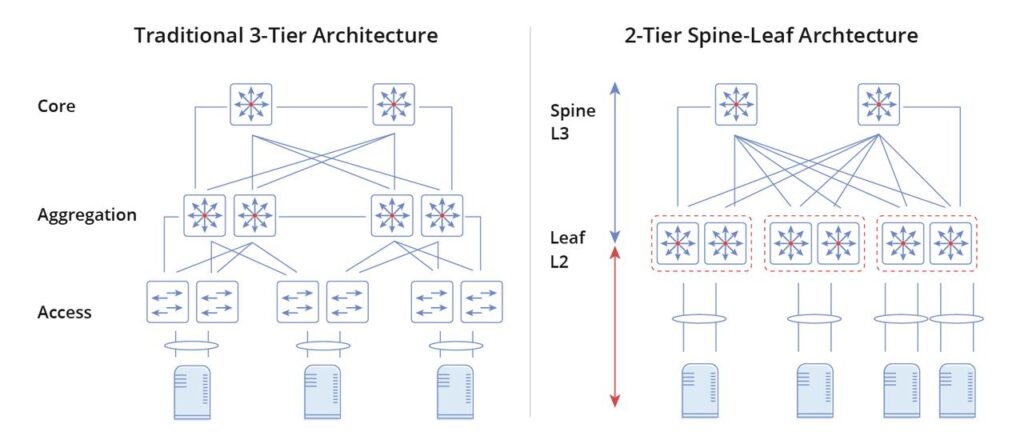Demand for GPUs and other computing hardware has risen sharply in recent years as demand for AI computing continues to grow. In particular, the reliance on high-speed data transfer for AI training in data centres has driven an equally dramatic increase in the demand for AI server clusters and 800G optical module transceivers. As data centre infrastructure continues to expand, the use of optical modules has grown exponentially. At present, 200G and 400G transceivers have been deployed on a large scale, and 800G optical transceivers have begun to enter the mass production and introduction stage.
Why Do We Need 800G Optical Transceiver?
With the dramatic increase in global demand for data consumption and the associated technological advancements such as cloud computing, video streaming, AI and the global deployment of 5G networks, there is a growing need for high-speed data transmission in the marketplace. 800G optical transceivers have been created to provide the necessary bandwidth and speeds to efficiently handle the increased traffic and datasets, ensuring that technological development is not limited by data transmission rates. Market research firms forecast the 800G optical module market to grow at a CAGR of more than 25% over the next few years, reaching a market size of more than $5 billion by 2025.In addition, 800G optical transceivers meet industry requirements for scalability, flexibility and future readiness by improving energy and cost efficiency for data transmission. They allow networks to achieve higher bandwidth densities with fewer devices and connections while reducing power consumption per bit, helping data centre and telecom providers control operating costs while expanding network capacity and safeguarding the long-term value of investments.
Updating Data Centre Topology Architecture
Data centre network architectures are constantly evolving as data centre computing scales and east-west traffic continues to expand. In a traditional three-tier topology, data exchange between servers must go through access, aggregation, and core switches, which puts tremendous load pressure on the aggregation and core switches.
When further expanding the size of the server cluster with a conventional three-layer topology, the cost of the devices increases dramatically, as high-performance devices have to be deployed in the core and aggregation layers.
Instead, a two-layer Spine-Leaf topology is used to flatten the traditional three-layer architecture into two layers. In this setup, Leaf switches are similar to access layer switches in a traditional three-tier architecture, connecting directly to the servers. Spine switches, on the other hand, are equivalent to core layer switches and are directly connected to leaf switches, and each spine switch is connected to all leaf switches.

Compared to the traditional three-layer topology architecture, the spine-leaf architecture requires a significantly larger number of ports. Consequently, both servers and switches require more optical modules for fibre optic communication. For extensive AI training applications utilising GPUs, in NVIDIA’s DGX H100 servers, which integrate 8 H100 GPUs, the demand for compute and storage networking corresponds to approximately 12 800G optical transceivers and 18 400G optical transceivers. More information can be found in this post: Introduction to NVIDIA DGX H100.
This indicates that the number of high-speed optical modules required in data centres under leaf-spine architecture increases exponentially. As data centres scale up, especially with the demand for AI large model training, and the increased need for higher transmission rates in GPU servers, the adoption pace of 800G optical modules is accelerating.
Accelerated Deployment of FS 800G Optical Transceivers
Against the backdrop of AI computing advancement, the demand for 800G modules is steadily rising, with leading global manufacturers intensifying their deployment efforts. Interstellar Optics, for instance, has begun ramping up the production of its 800G optical modules in the first half of 2023, delivering steadily to key overseas clients alongside GPU-matched 800G products.
FS offers 800G optical transceivers of different transmission types, such as 800G QSFP-DD SR8, 800G OSFP SR8 and 800G OSFP 2xFR4, etc. Built-in Broadcom DSP chips, OSFP transceivers deliver high speed and low power consumption over 800G links, with a maximum fibre distance of up to 50m using 8 multimode fibres. Ideal for use in InfiniBand NDR end-to-end systems, FS 800G optical transceivers are an ideal solution for the supercomputing and AI industries, seamlessly integrating into computing and storage infrastructures to ensure efficient, high-performance interconnects.
And FS provides modules with two different protocols, InfiniBand and Ethernet. No matter what application scenario you face, our products can meet your needs. From high-speed data transmission to network expansion, FS’s 800G modules will provide you with excellent performance and reliability to help you achieve the success of digital transformation.
| QDD-SR8-800G | OSFP-SR8-800G | OSFP-2FR4-800G | |
| Center Wavelength | 850nm | 850nm | 1271nm, 1291nm, 1311nm and 1331nm |
| Connector | MTP/MPO-16 | Dual MPO-12/APC | Dual LC Duplex |
| Cable Distance (Max.) | 30m@OM3/50m@OM4 | 30m@OM3 50m@OM4 | 2km |
| Modulation | 8×106.25G PAM4 | 8×106.25G PAM4 | 8×106.25G PAM4 |
| Transmitter Type | VCSEL | VCSEL | EML |
| Packaging Technology | COB (Chip on Board) Packaging | COB (Chip on Board) Packaging | COB (Chip on Board) Packaging |
| Chip | Broadcom 7nm DSP Chip | Broadcom 7nm DSP | Broadcom 7nm DSP Chip |
| Power Consumption | ≤13W | ≤15W | ≤16.5W |
| Application | Ethernet Data Center | InfiniBand 800G to 800G 800G to 2x400G Breakout | Ethernet Data Center 800G to 2x400G |
Summary
With the certainty of GPU orders driving demand, the mass shipment phase for 800G optical transceivers is set to commence in the latter half of this year. Serving as a vital link for AI computing power, the 800G optical transceivers are poised to witness accelerated market growth and deployment rates fueled by the expanding scale of data centres and the continuous rise in demand for AI training.
Related Articles:
Unveiling the Future: The Evolution of 800G OSFP Optical Transceivers
Unlocking Next-Gen Connectivity with the 800G OSFP Transceiver



